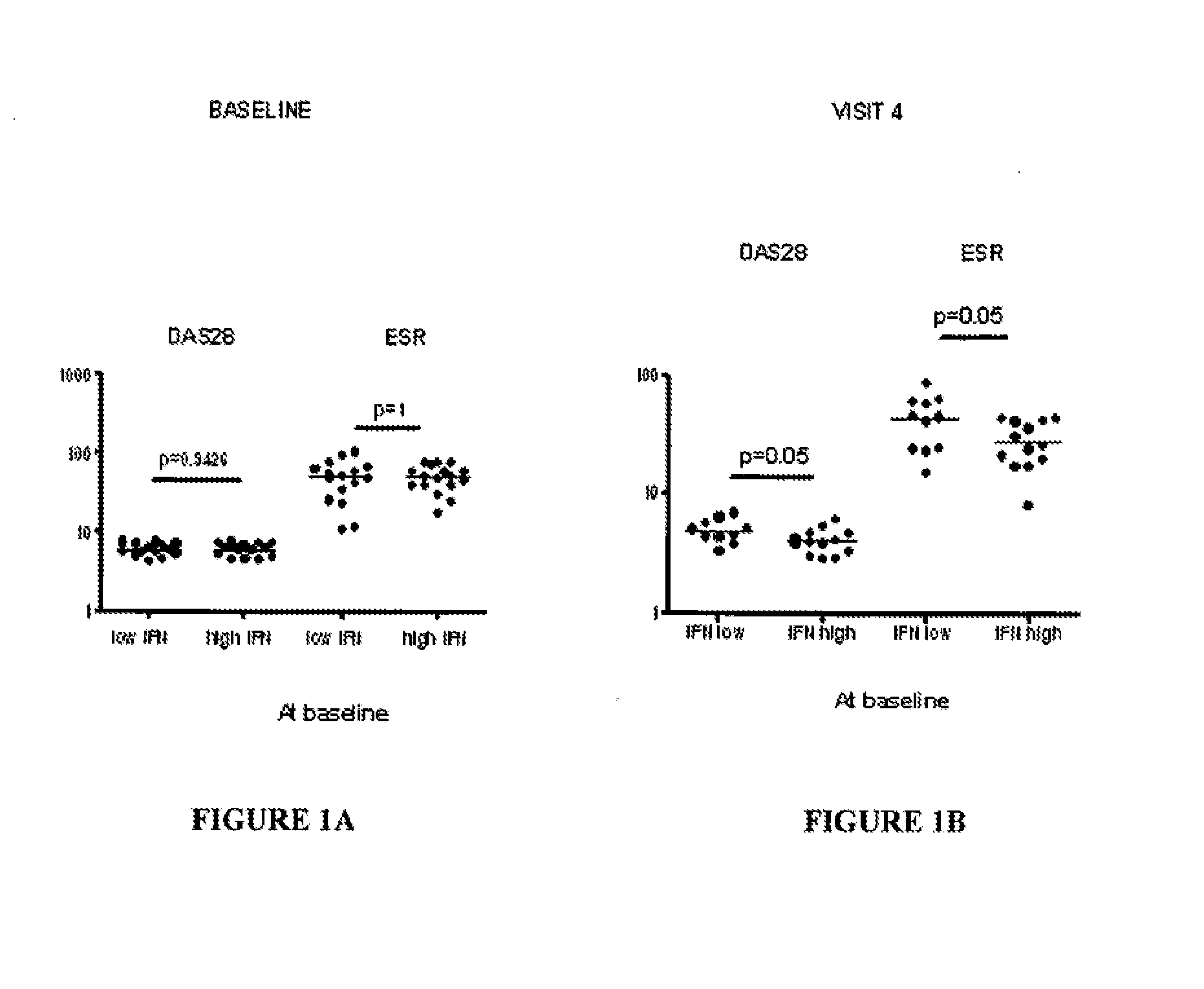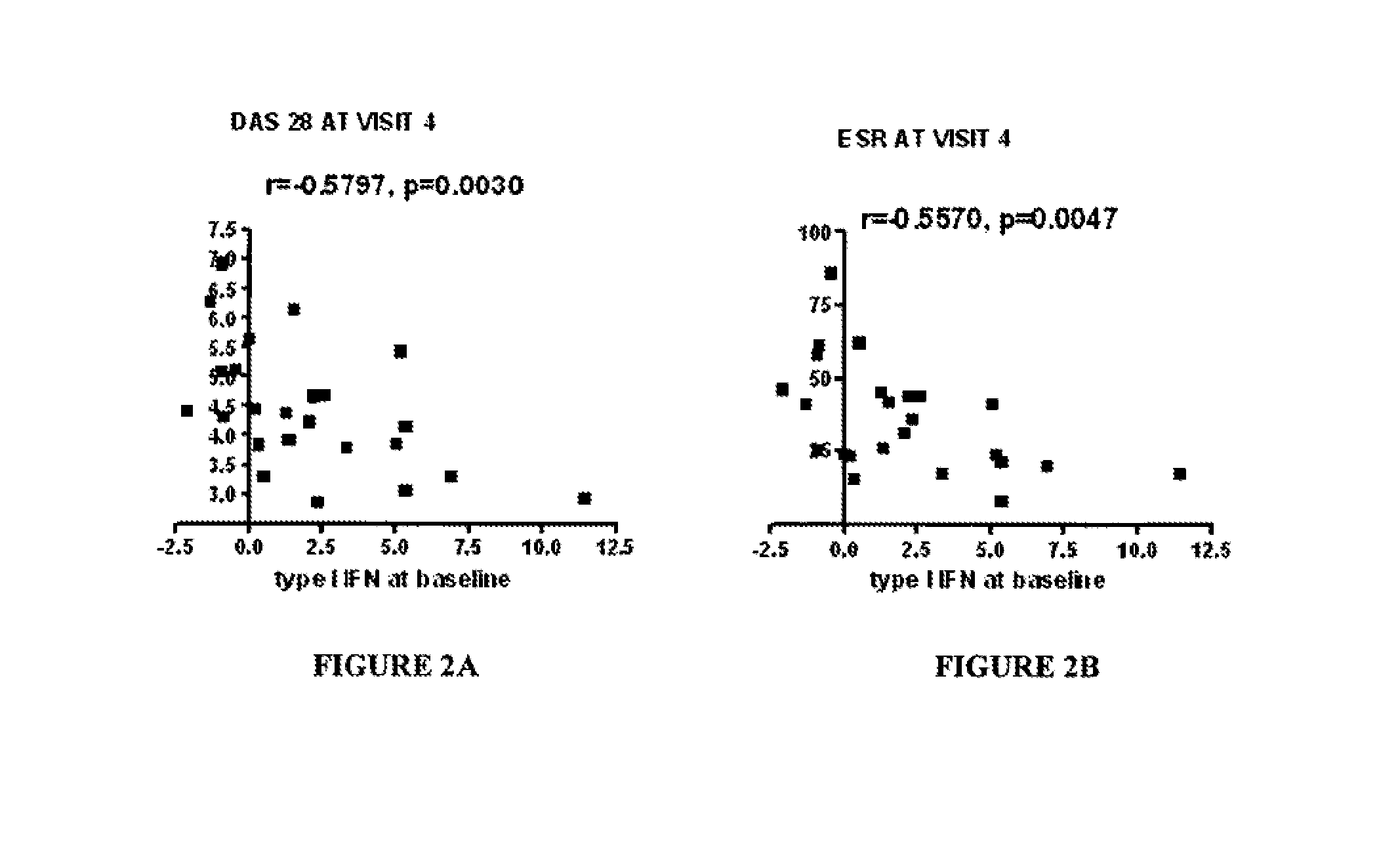Methods For Determining Anti-TNF Therapeutic Response
a technology of anti-tnf and therapeutic response, applied in the field of methods for determining anti-tnf therapeutic response, can solve the problems of limiting the ability of tnf receptors to engage cell membrane tnf receptors and activate inflammatory pathways, inadequate clinical or radiographic responses to these agents, and difficult measurement to apply to patient clinical managemen
- Summary
- Abstract
- Description
- Claims
- Application Information
AI Technical Summary
Benefits of technology
Problems solved by technology
Method used
Image
Examples
example 1
[0096]Blood samples were obtained from RA patients at baseline or approximately 6 months after beginning therapy with an anti-TNF agent (e.g., etanercept, infliximab or adalimumab). Type I interferon activity was measured using an assay that quantifies type I interferon activity in plasma. WISH epithelial cell line cells were incubated with patient plasma for 6 hours and expression of several interferon-inducible genes was measured by real-time PCR. An interferon score was derived using these data.
[0097]FIGS. 1A-B demonstrate disease activity [expressed as either disease activity score 28 (DAS28) (FIG. 1A) or erythrocyte sedimentation rate (ESR)] at baseline (prior to anti-TNF therapy) and at visit 4 after initiating anti-TNF therapy (FIG. 1B) (approximately the six month time point) in RA patients with either high or low plasma type I interferon activity at baseline. DAS28 and ESR were comparable among RA patients with high and low plasma type I interferon activity at baseline, but...
example 2
[0101]Further testing of RA plasma samples, including those assayed for Type I interferon as described in FIGS. 1-3 with specific anti-interferon antibodies, shows an interesting detection profile. In particular, the RA samples exhibit inhibition by anti-IFN-α antibodies, and also inhibition by anti-IFN-β antibodies. Combining these inhibition values and generating a ratio of the sample inhibition by anti-IFN-β compared to the inhibition conferred by anti-IFN-α has provided a useful profile for predicting response to anti-TNF therapy. As shown in FIGS. 4-6, plasma samples tested in this manner illustrated that those with a relatively higher ratio of anti-IFN-β inhibition to anti-IFN-α inhibition (presumably indicating a relatively greater proportion of IFN-β in their plasma) were the ones that had the best response to anti-TNF therapy, indicated by a lower disease activity score in these patients. It is also contemplated that an amount of IFN-β predictive for anti-TNF responders can...
example 3
[0103]The baseline characteristics of anti-TNF treated RA patients according to response to therapy are presented in Table 3. While no significant differences were revealed among the three groups in sex and race, medications or disease activity and duration, the group with moderate response was significantly older compared to that of the non-response group [mean (range) in years: 49(32-64) versus 38(21-55), p=0.0342].
TABLE 3Baseline Characteristics of ANTI-TNF Treated RA PatientsClassified at Visit 4 as Good, Moderate and Non-RespondersAccording to EULAR Response Criteria.Non ResponseModerate ResponseGood Response(n = 7)(n = 25)(n = 6)Agea38 (21-55) 49 (32-64)* 42 (32-51)Sex (F %)b100% 96%100% Race (H / A / C)c6 / 0 / 124 / 1 / 06 / 0 / 0Disease durationd 8 (0.5-30.4)12 (0.4-30.7) 7 (2.7-11.6)DAS28e5.7 (4.6-7.1)6.4 (4.2-8.0) 5.8 (4.5-7.4)Prednisonef57%28%50%(4 mg / d)(2 mg / d)(4 mg / d)DMARDgMTX100% 84%67%HCQ57%52%84%LEF 0%16%17%SSA14%32%17%Rheumatoid1121 ± 1256635.2 ± 880.7 810 ± 1608fa...
PUM
| Property | Measurement | Unit |
|---|---|---|
| temperatures | aaaaa | aaaaa |
| temperatures | aaaaa | aaaaa |
| temperatures | aaaaa | aaaaa |
Abstract
Description
Claims
Application Information
 Login to View More
Login to View More - R&D
- Intellectual Property
- Life Sciences
- Materials
- Tech Scout
- Unparalleled Data Quality
- Higher Quality Content
- 60% Fewer Hallucinations
Browse by: Latest US Patents, China's latest patents, Technical Efficacy Thesaurus, Application Domain, Technology Topic, Popular Technical Reports.
© 2025 PatSnap. All rights reserved.Legal|Privacy policy|Modern Slavery Act Transparency Statement|Sitemap|About US| Contact US: help@patsnap.com



